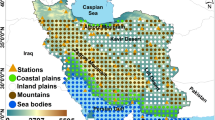Abstract
The relationship between surface rain rate and depth of rain system (rain depth) over Southeast Asia is examined using 10-yr Tropical Rainfall Measuring Mission (TRMM) precipitation radar (PR) measurements. Results show that, in general, a large surface rain rate is associated with a deep precipitating system, but a deep rain system may not always correspond with a large surface rain rate. This feature has a regional characteristic. Convective rain develops more frequently over land than over the ocean, while stratiform rain can extend to higher altitudes over the ocean than over land. A light surface rain rate has the largest probability to occur, regardless of rain depth. A convective rain system is more likely associated with a stronger surface rain rate than a stratiform rain system. Results show that precipitation systems involve complex microphysical processes. Rain depth is just one characteristic of precipitation. A linear relationship between surface rain rate and rain depth does not exist. Both deep convective and stratiform rain systems have reflectivity profiles that can be divided into three sections. The main difference in their profiles is at higher levels, from 4.5 km up to 19 km. For shallow stratiform rain systems, a two-section reflectivity profile mainly exists, while for convective systems a three-section profile is more common.
Similar content being viewed by others
References
Awaka, J., T. Iguchi, and K. Okamoto, 1998: Early results on rain type classification by the Tropical Rainfall Measuring Mission (TRMM) precipitation radar. Proc. 8th URSI Commission F Open Symp., Averior, Portugal, 134–146.
Du, B., and Z. Gao, 1998: An investigation on vertical profiles of radar reflectivity and precipitation estimation with remotely sensed data. Journal of Nanjing Institute of Meteorology, 21, 729–736. (in Chinese)
Fu, R., L. Hu, G. J. Gu, and Y. D. Li, 2008: A comparison study of summer-time synoptic-scale waves in South China and the Yangtze River Basin using the TRMM multi-satellite precipitation analysis daily product. Science in China (D), 51(1), 114–122.
Fu, Y. F., 2006: Precipitation structures of a thermal convective system happened in the central Western Subtropical Pacific Anticyclone. Acta Meteorologica Sinica, 20, 232–243.(in Chinese)
Fu, Y. F., and G. S. Liu, 2001: The variability of tropical precipitation profiles and its impact on microwave brightness temperatures as inferred from TRMM data. J. Appl. Meteor., 40, 2130–2143.
Fu, Y. F., and G. S. Liu, 2003: Precipitation characteristics in mid-latitude East Asia as observed by TRMM PR and TMI. J. Meteor. Soc. Japan, 81(6), 1353–1369.
Fu, Y. F., Y. H. Lin, G. S. Liu, and Q. Wang, 2003: Seasonal characteristics of precipitation in 1998 over East Asia as derived from TRMM PR. Adv. Atmos. Sci., 20(4), 511–529, doi: 10.1007/BF02915495.
Fu, Y. F., G. S. Liu, G. X. Wu., R. C. Yu, Y. P. Xu, Y. Wang, R. Li, and Q. Liu, 2006: Tower mast of precipitation over the central Tibetan Plateau summer. Geophys. Res. Lett., 33, doi: 10.1029/2005GL024713.
Hu, L., S. Yang, and Y. D. Li, 2010a: Diurnal and seasonal climatology of precipitation depth over Tibetan Plateau and its downstream regions. Chinese J. Atmos. Sci., 34(2), 387–392.
Hu, L., S. Yang, Y. D. Li, and S. T. Gao, 2010b: Diurnal variability of precipitation depth over Tibetan Plateau and its surrounding regions. Adv. Atmos. Sci., 27(1), 115–122, doi: 10.1007/s00376-009-8193-5.
Kodama, Y. M., and A. Tamaoki, 2002: A re-examination of precipitation activity in the subtropics and the mid-latitudes based on satellite-derived data. J. Meteor. Soc. Japan, 80, 1261–1278.
Kummerow, C., and Coauthors, 2000: The status of the Tropical Rainfall Measuring Mission (TRMM) after two years in orbit. J. Appl. Meteor., 39, 1965–1982.
Li, J., and J. Luo, 2006: Estimation of rainfall of stable stratiform clouds with radar echo features. Meteorological Monthly, 32, 34–39. (in Chinese)
Li, Y. D., Y. Wang, S. Yang, L. Hu, S. T. Gao, and R. Fu, 2008: Characteristics of summer convective systems initiated from Tibetan Plateau. Part I: Origin, track, development and precipitation. J. Appl. Meteor. Climatol., 47(10), 2679–2695.
Liu, C., and E. J. Zipser, 2009: “Warm rain” in the tropics: Seasonal and regional distribution based on 9 years of TRMM data. J. Climate, 22(1), 767–779.
Liu, G., and T. Takeda, 1989: Two types of stratiform precipitating clouds associated with cyclones. Tenki, 36, 147–157. (in Japanese)
Liu, Q., and Y. F. Fu, 2007: Study of rainfall of summer in Asia based on TRMM/TMI. Science in China (D), 37(1), 111–122. (in Chinese)
Xu, Y., 1992: Radar echo features and their relations to rainfall for heavy frontal rains in the Pearl River Delta. Journal of Tropical Meteorology, 8, 174–180. (in Chinese)
Yang, S., and E. A. Smith, 2008: Convective-stratiform precipitation variability at seasonal scale from eight years of TRMM observations: Implications for multiple modes of diurnal variability. J. Climate, 21, 4087–4114.
Yang, S., K. S. Kuo, and E. A. Smith, 2008: Persistent nature of secondary diurnal modes in both land and ocean precipitation. J. Climate, 21, 4115–4131.
Yuter, S. E., and R. A. Houze, 1995: Three-dimensional kinematic and microphysical evolution of Florida cumulonimbus. Part II: Frequency distributions of vertical velocity, reflectivity, and differential reflectivity. Mon. Wea. Rev., 123, 1941–1963.
Zipser, E. J., and K. R. Lutz, 1994: The vertical profile of radar reflectivity of convective cells: A strong indicator of storm intensity and lightning probability. Mon. Wea. Rev., 122, 1751–1759.
Author information
Authors and Affiliations
Corresponding author
Rights and permissions
About this article
Cite this article
Hu, L., Li, Y. & Deng, D. An investigation into the relationship between surface rain rate and rain depth over Southeast Asia. Adv. Atmos. Sci. 30, 142–152 (2013). https://doi.org/10.1007/s00376-012-2097-5
Received:
Revised:
Published:
Issue Date:
DOI: https://doi.org/10.1007/s00376-012-2097-5



